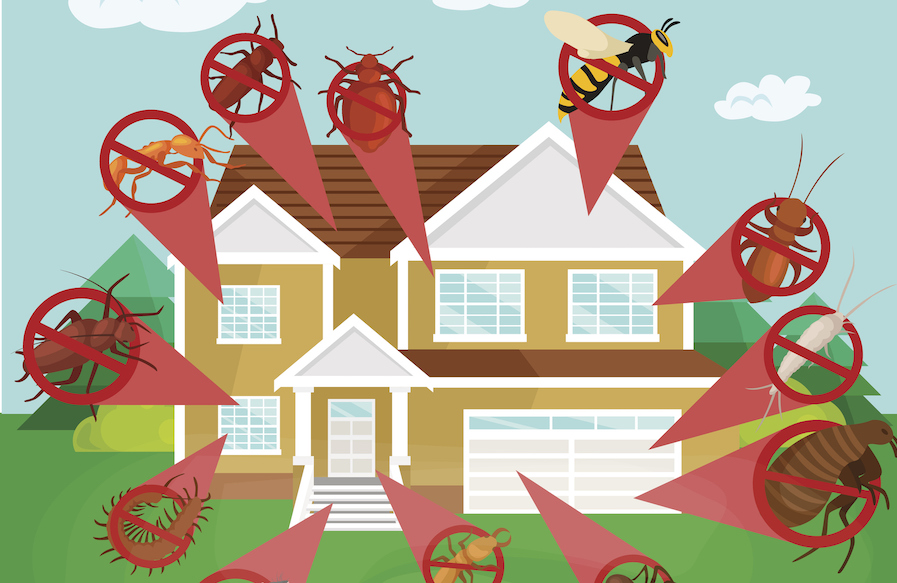Pest-free zone: How to rid you home of ants, wasps, roaches and moths this summer
Unfasten the shutters, throw open the windows and let in some much needed fresh air – summer is truly on the way.
Unfortunately, this can also mean irksome creepy-crawlies that may be inclined to invade your home during the warmer months. Some of them might even interpret your open window as a gilded invitation to enter.
Here’s how to save your home from the seasonal bug barrage, from calling in exterminators to putting your suits in the freezer…
Clothes moths

It’s the fashionable homeowner’s worst nightmare: Throwing open your wardrobe to find that a biblical plague of clothes moths have turned your Sunday best into their own personal munching ground.
The first most people know of a moth invasion is shelf-loads of ruined fabric, so preventative measures are best. Moths prefer to dine on animal-based fabrics, so your silk socks and cashmere cardigans should be priorities for protection.
They thrive in dusty condition, so your first line of defence should be a clean, well-ordered wardrobe in regular use. Buy high quality garment bags to guard higher-value hanging items, pack your woolly jumpers into compression bags if you can (you probably won’t be needing them until autumn anyway), and thoroughly vacuum your wardrobe to expel well-hidden larvae.
Don’t heat rooms unnecessarily (moths like it cosy), get rid of unwanted clothes promptly to stop them becoming a breeding ground, and beat your rugs once every couple of weeks. Perhaps most of all – beware buying vintage and second-hand, particularly if it’s made from moth-prone material. We’re not saying don’t ever buy from a charity shop – just be mindful and be sure to get items appropriately cleaned before chucking them in with the rest of your clothes.
If it’s already too late, discard any badly damaged clothing immediately, inflict on your closet the deepest of deep cleans, and pack away endangered items in the freezer for at least 72 hours. The cold should kill off any extant larvae and eggs.
Mothballs can work but should really be a last resort and considered carefully – they’re full-blown pesticides and breathing large amounts isn’t very good for you. More eco and lung-friendly are sticky pheromone traps, which attract and ensnare male moths, ensuring they can’t breed.
Wasps

About as friendly as they look
Of all household pests, wasps are perhaps the most intimidating. Through spring and early summer, the buzz of a worker wasp rings alarms bells for even the hardiest homeowner, aware that thousands of fellows could soon follow to nest in attic, chimney or eaves.
We’re right to be wary – wasps can attack in numbers when provoked, and a nest can contain literally thousands. If the nest is remote and easily avoided, it might be simpler to wait out the season than risk the wrath of the hive-mind, though consider potential consequences for curious children or pets.
Wasp nests can theoretically be removed with designated insecticide, but you should only attempt this with small, easily accessible nests, if you’re certain you’re not allergic, and feel confident you’re taking all necessary steps to tackle the job safely and protect yourself and others. Generally speaking, we recommend calling in a professional.
Ants

Teamwork is a powerful thing
Think how annoying ants can be on a picnic. Now think how head-bangingly irritating that would be transposed into your pantry. Ironically, ants are efficient predators of fellow pests like bed bugs and fleas – but once they start turning up in the butter they’ve overstayed their welcome.
Ants are small, tenacious and numerous – so your only real recourse is brute force. Commercial insecticides are generally effective – anti-ant gels and powders masquerade as food and are carried back to base by the unsuspecting workers. In a domestic setting however, chemical solutions aren’t for everyone and might not be sensible if you have tots and pets, and there are various home remedies that have proven effective against the invaders that you might want to consider.
Use their sweet tooth against them – mix a tablespoon of boric acid with sugar in a one-to-three ratio, and lace it around the entrance to the nest. The ants will carry the mixture inside, where it will promptly kill all that consume it.
Less deadly but often equally effective solutions include diluted white vinegar and lemon juice. Neither are likely to kill an entire colony, but the smell is so unpleasant to their little ant noses that it might force them to relocate.
Cockroaches

Man’s most tenacious foe
The story goes that in the event of a nuclear holocaust, cockroaches would be the only animals resilient enough to survive. Thankfully we’ve never had the opportunity to test this, but you can imagine how hard they must be to dislodge from your kitchen.
As is so often the case, prevention is preferable to cure. A dirty kitchen is a roach-friendly kitchen – an overturned cereal box at the back of a cupboard, leftovers that missed the bin, crumbs festering behind the fridge and so on. Pack food away in sealed containers and do not leave any out in the open.
Seal obvious entry points to your home – cracked walls, draughty doors, torn windows screens etc – and invest in a fully sealed rubbish bin. Non-edible clutter like paper and cardboard can provide a perfect home for a family of roaches too, so tidiness is nearly as important as cleanliness.

The roaches laugh at your puny spray can
Once established, roaches live up to their reputation as some of the baddest critters in the business. Insecticidal sprays are not generally effective, while bait stations are expensive and only moderately better.
Make your home as roach-unfriendly as possible, and if the problem persists, call in the experts.
The Press Association
Latest posts by The Press Association (see all)
- BBC to air two-part Call The Midwife Christmas special - December 23, 2024
- 6 mind sports to exercise your brain and keep you sharp - December 20, 2024
- Quiz: What classic Christmas food or drink are you? - December 20, 2024
- Leftover turkey and watercress pie - December 20, 2024
- Catherine and William choose family shot for Christmas card photograph - December 19, 2024




















